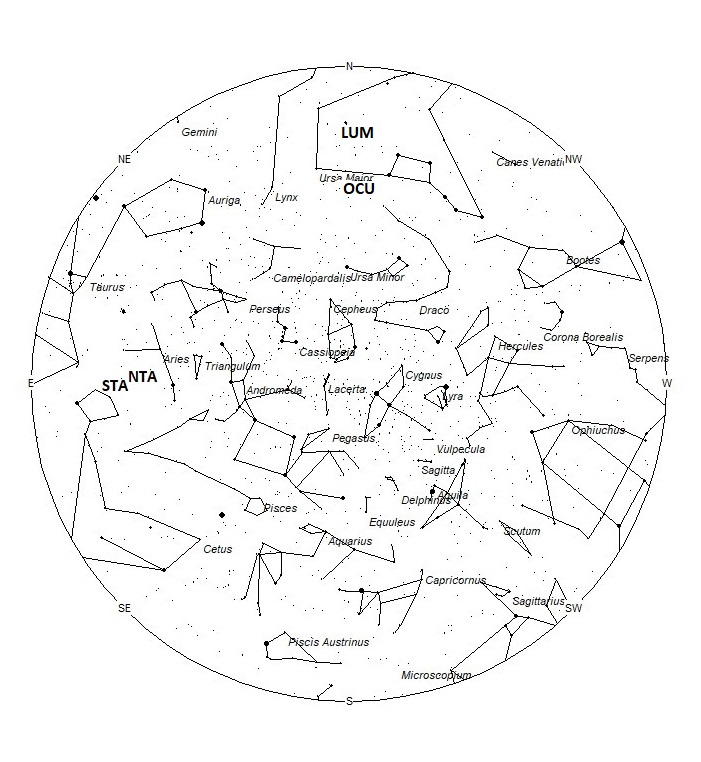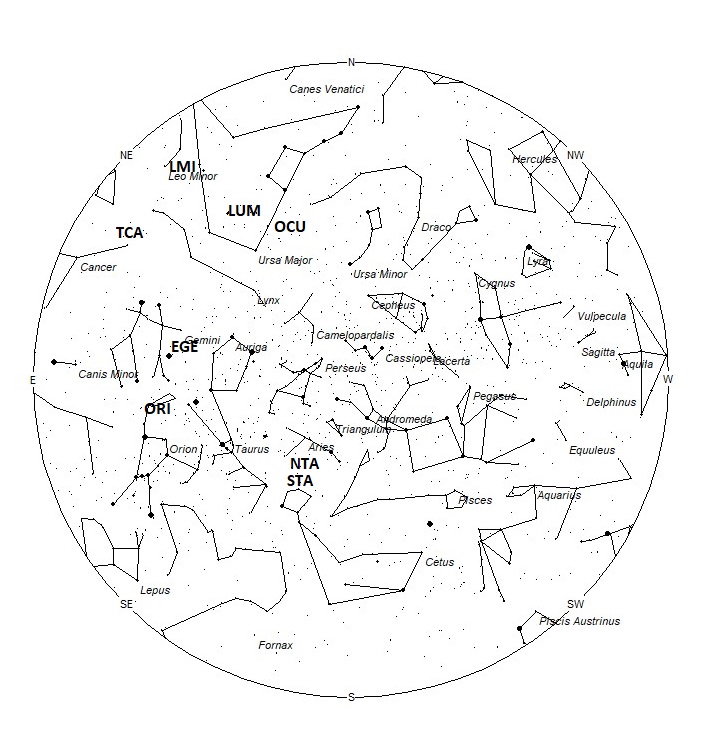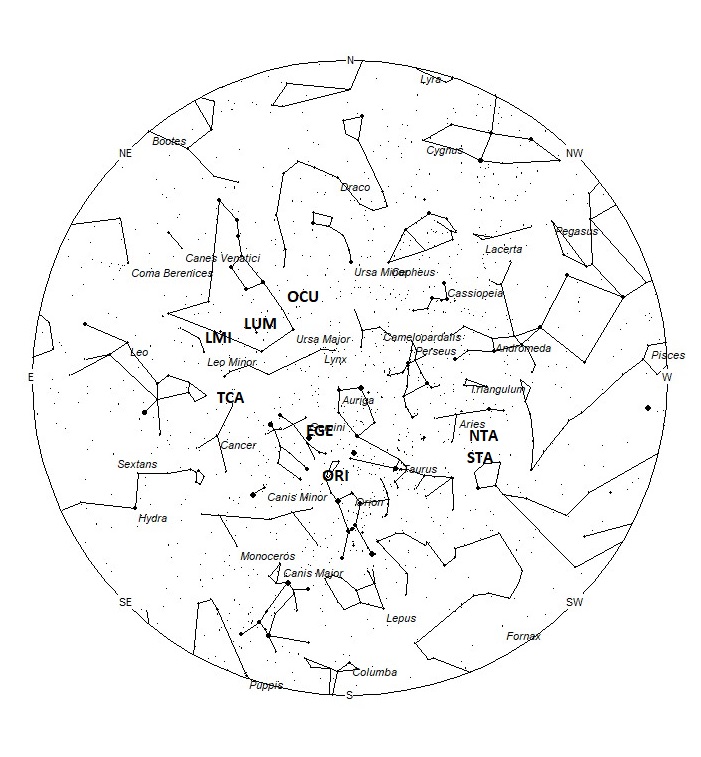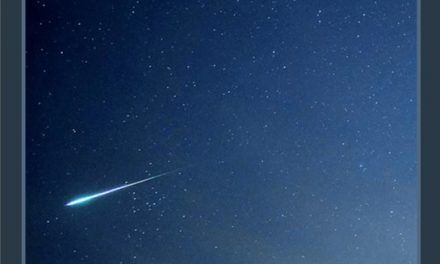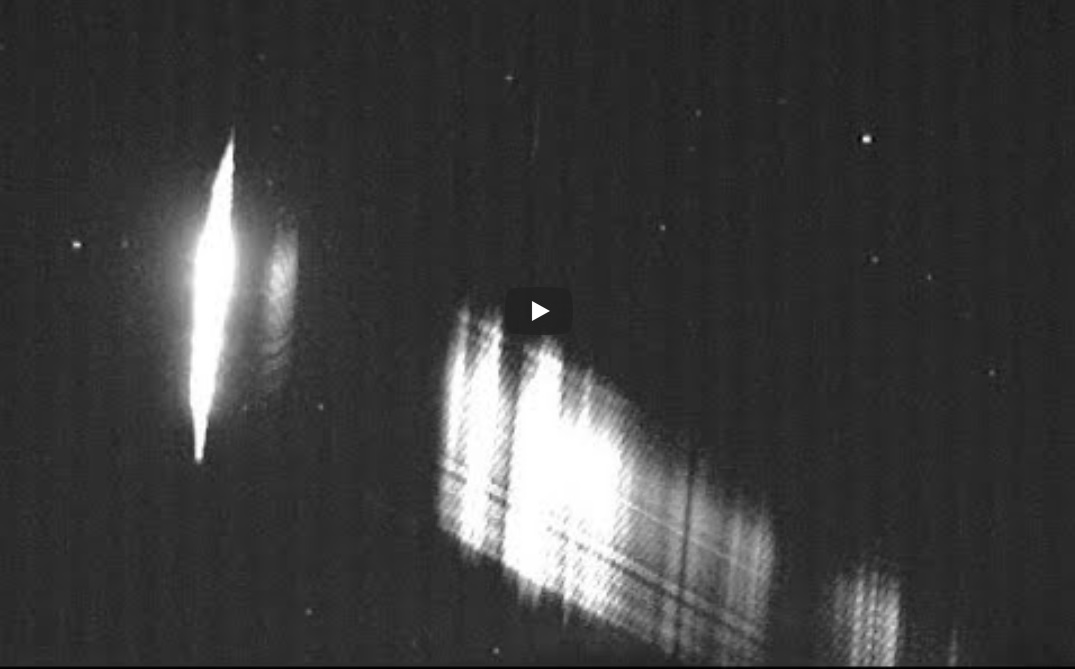During this period, the moon reaches its last quarter phase on Monday October 17th. At that time the moon will lie 90 degrees west of the sun and will rise between 22:00-23:00 local Summer time (LST). As the week progresses the waning crescent moon will rise later with each passing morning, allowing viewing conditions to improve as the week progresses. This weekend the evening hours will be free of interfering moonlight. The morning hours will have a bright moon, but one can still observe meteor activity by facing away from the moon, avoiding the bright moonlight from ruining your night vision. The estimated total hourly rates for evening observers this week should be near 4 as seen from mid-northern latitudes (45N) and 3 as seen from tropical southern locations (25S) For morning observers, the estimated total hourly rates should be near 17 as seen from mid-northern latitudes (45N) and 12 as seen from tropical southern locations (25S). The actual rates will also depend on factors such as personal light and motion perception, local weather conditions, alertness, and experience in watching meteor activity. Morning rates are reduced this week due to interfering moonlight. Note that the hourly rates listed below are estimates as viewed from dark sky sites away from urban light sources. Observers viewing from urban areas will see less activity as only the brighter meteors will be visible from such locations.
The radiant (the area of the sky where meteors appear to shoot from) positions and rates listed below are exact for Saturday night/Sunday morning October 15/16. These positions do not change greatly day to day so the listed coordinates may be used during this entire period. Most star atlases (available at science stores and planetariums) will provide maps with grid lines of the celestial coordinates so that you may find out exactly where these positions are located in the sky. I have also included charts of the sky that display the radiant positions for evening, midnight, and morning. The center of each chart is the sky directly overhead at the appropriate hour. These charts are oriented for facing south but can be used for any direction by rotating the charts to the desired direction. A planisphere or computer planetarium program is also useful in showing the sky at any time of night on any date of the year. Activity from each radiant is best seen when it is positioned highest in the sky, either due north or south along the meridian, depending on your latitude. It must be remembered that meteor activity is rarely seen at the radiant position. Rather they shoot outwards from the radiant, so it is best to center your field of view so that the radiant lies at the edge and not the center. Viewing there will allow you to easily trace the path of each meteor back to the radiant (if it is a shower member) or in another direction if it is sporadic. Meteor activity is not seen from radiants that are located far below the horizon. The positions below are listed in a west to east manner in order of right ascension (celestial longitude). The positions listed first are located further west therefore are accessible earlier in the night while those listed further down the list rise later in the night.
These sources of meteoric activity are expected to be active this week.
.
Members of the Northern Taurids (NTA) should start appearing this weekend from a radiant located at 02:34 (39) +17. This area of the sky is located in central Aries, 6 degrees southeast of the 2nd magnitude star known as Hamal (alpha Arietis). To best see these meteors, one should face southward near 02:00. Maximum activity is not until November 12th so rates at this time should be less than 1 per hour no matter your location. With an entry velocity of 32 km/sec., the average NTA meteor would be of medium-slow velocity.
The Southern Taurids (STA) are very complex and recent investigations have revealed two distinct components of this meteor shower. The first component represents the early and regular annual activity of Southern Taurids, and the latter component represents the main source of activity and is periodic. The early STA’s are active from September 28 through November 7 and peaks on October 17th. The main component of the STA’s is active from October 13 through December 2 and peaks on November 5th*. These two components lie only 5 degrees apart and would be difficult to distinguish by visual means. Therefore, we will list the mean position of these two sources which happens to be 02:40 (40) +12. This position lies in southern Aries, 2 degrees north of the 4th magnitude star known as mu Ceti. Like the NTA’s, to best see these meteors one should face southward near 02:00. Rates at this time should be near 4 per hour as seen from the Northern Hemisphere and 3 per hour as seen from south of the equator. With an entry velocity of 31 km/sec., the average STA meteor would be of medium-slow velocity.
*The activity of meteor showers recorded by SonotaCo Net video observations 2007–2018, Masahiro Koseki, 2021, https://www.meteornews.net/2021/02/09/february-2021-special-issue-of-emeteornews-online/ Page 170
The Orionids (ORI) are active from September 26 through November 22, with maximum activity occurring on October 21st. The radiant is currently located at 06:02 (091) +15, which places it in northeastern Orion, 1 degree west of the 4th magnitude star known as nu Orionis. To best see these meteors, face toward the south during the last hours prior to dawn. Current rates are expected to be near 3 per hour, no matter your location. With an entry velocity of 66 km/sec., the average ORI meteor would be of swift velocity. Also see: https://www.amsmeteors.org/2022/10/viewing-the-orionid-meteor-shower-in-2022/
The epsilon Geminids (EGE) are active from a radiant located at 06:36 (099) +29. This area of the sky lies on the Gemini/Auriga border, 5 degrees north of the 3rd magnitude star known as Mebsuta (epsilon Geminorum). To best see these meteors, face toward the southeast during the last hours prior to dawn. These meteors are active from September 27 through November 8, with maximum activity occurring on October 19. Hourly rates at this time should be near 1 as seen for the Northern Hemisphere and less than 1 per hour as seen from south of the equator. With an entry velocity of 69 km/sec., the average EGE meteor would be of swift velocity.
The tau Cancrids (TCA) are a weak shower with a long activity period of seven weeks. They are active from September 23 through November 12 with maximum activity occurring on October 20th. The radiant currently lies at 08:55 (134) +30, which places it in northern Cancer, 2 degrees northeast of the 4th magnitude star known as iota Cancri A. To best see these meteors, face eastward during the last two hours of the morning prior to dawn. Expected hourly rates are less than 1 per hour no matter your location. With an entry velocity of 67 km/sec., the average TCA meteor would be of swift velocity.
The lambda Ursa Majorids (LUM) were discovered by Željko Andreić and the Croatian Meteor Network team based on studying SonotaCo and CMN observations (SonotaCo 2007-2011, CMN 2007-2010). These meteors are active from October 18 through November 7, with maximum activity occurring on October 28th. The current location of the LUM radiant lies near 09:48 (145) +53. This area of the sky lies in western Ursa Major, 2 degrees northeast of the 3rd magnitude star known as theta Ursae Majoris. This area of the sky is best placed in the sky during the last hour before dawn, when it lies highest above the northeastern horizon in a dark sky. Current rates should be less than 1 per hour no matter your location. Due to the high northern location of this radiant, these meteors are difficult to see from the Southern Hemisphere. With an entry velocity of 61km/sec., most activity from this radiant would be of swift speed.
The October Ursa Majorids (OCU) are a recent discovery by the Japanese group known as SonotaCo. These meteors are active from October 10-20 with maximum activity occurring on October 16th. The radiant is currently located at 09:46 (147) +64. This position lies in northwestern Ursa Major 5 degrees north of the 4th magnitude star known as upsilon Ursae Majoris. This area of the sky is best placed in the sky during the last hour before dawn, when it lies highest above the northeastern horizon in a dark sky. Current rates would be most likely less than 1 per hour no matter your location. But near maximum, rates may reach 2 per hour during the late morning hours as seen from the Northern Hemisphere. Like the LUM’s, these meteors are difficult to see from the Southern Hemisphere. With an entry velocity of 55km/sec., most activity from this radiant would be of swift speed.
The Leonis Minorids (LMI) are active from October 13th to November 3rd, with maximum activity occurring on October 21st. The radiant is located at 10:12 (153) +39, which places it in northern Leo Minor, 3 degrees northwest of the 4th magnitude star known as beta Leonis Minoris. These meteors are best seen by facing toward the east during the last couple of hours prior to dawn. This shower is better for observers situated in the Northern Hemisphere where the radiant rises far higher into the sky before the start of morning twilight. Current rates would be less than 1 no matter your location. At 62km/sec., the average Leonis Minorid is swift. From my personal experience this minor shower produces a high proportion of bright meteors.
Sporadic meteors are those meteors that cannot be associated with any known meteor shower. All meteor showers are evolving and disperse over time to the point where they are no longer recognizable. Away from the peaks of the major annual showers, these sporadic meteors make up the bulk of the activity seen each night. As seen from the mid-Northern Hemisphere (45N) one would expect to see during this period approximately 9 sporadic meteors per hour during the last hour before dawn as seen from rural observing sites. Evening rates would be near 3 per hour. As seen from the tropical Southern latitudes (25S), morning rates would be near 6 per hour as seen from rural observing sites and 2 per hour during the evening hours. Locations between these two extremes would see activity between these listed figures.
You can keep track of the activity of these meteor showers as well as those beyond the limits of visual observing by visiting the NASA Meteor Shower Portal available at: https://meteorshowers.seti.org/ You can move the sky globe to see different areas of the sky. Colored dots indicate shower meteors while white dots indicate sporadic (random) activity. The large orange disk indicates the position of the sun so little activity will be seen in that area of the sky.
The list below offers the information in tabular form of the showers that I feel are within reach of the visual observer to discern. Hourly rates are often less than 1 but noting parameters such as the radiant distance and the elevation, one can compute the probably of shower association. Most showers discovered by video means have rates less than 1 per night away from maximum, so these listed showers are not as weak as they seem. Rates and positions are exact for Saturday night/Sunday morning except where noted in the shower descriptions.
| SHOWER | DATE OF MAXIMUM ACTIVITY | CELESTIAL POSITION | ENTRY VELOCITY | CULMINATION | HOURLY RATE | CLASS |
| RA (RA in Deg.) DEC | Km/Sec | Local Summer Time | North-South | |||
| Northern Taurids (NTA) | Nov 12 | 02:34 (39) +17 | 32 | 02:00 | <1 – <1 | II |
| Southern Taurids (STA) | Oct 17 | 02:40 (40) +12 | 31 | 02:00 | 4 – 3 | II |
| Orionids (ORI) | Oct 21 | 06:02 (091) +15 | 66 | 05:00 | 3 – 3 | I |
| epsilon Geminids (EGE) | Oct 19 | 06:36 (099) +29 | 69 | 06:00 | 1 – <1 | II |
| tau Cancrids (TCA) | Oct 20 | 08:55 (134) +30 | 66 | 08:00 | <1 – <1 | IV |
| October Ursa Majorids (OCU) | Oct 16 | 09:46 (147) +64 | 55 | 09:00 | <1 – <1 | IV |
| lambda Ursa Majorids (LUM) | Oct 28 | 09:48 (145) +53 | 61 | 09:00 | <1 – <1 | IV |
| Leonis Minorids (LMI) | Oct 21 | 10:12 (153) +39 | 62 | 09:00 | <1 – <1 | II |
Class Explanation: A scale to group meteor showers by their intensity:
- Class I: the strongest annual showers with Zenith Hourly Rates normally ten or better.
- Class II: reliable minor showers with ZHR’s normally two to ten.
- Class III: showers that do not provide annual activity. These showers are rarely active yet have the potential to produce a major display on occasion.
- Class IV: weak minor showers with ZHR’s rarely exceeding two. The study of these showers is best left to experienced observers who use plotting and angular velocity estimates to determine shower association. These weak showers are also good targets for video and photographic work. Observers with less experience are urged to limit their shower associations to showers with a rating of I to III.

